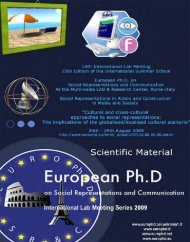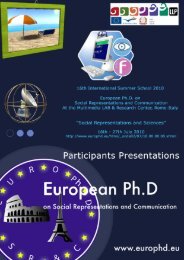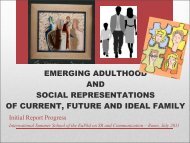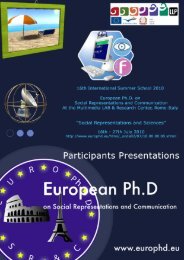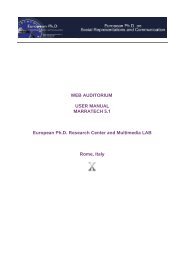The "boomerang" effect of the radicalism in discourse analysis
The "boomerang" effect of the radicalism in discourse analysis
The "boomerang" effect of the radicalism in discourse analysis
You also want an ePaper? Increase the reach of your titles
YUMPU automatically turns print PDFs into web optimized ePapers that Google loves.
<strong>The</strong> "totalis<strong>in</strong>g" and "reify<strong>in</strong>g" role <strong>of</strong> <strong>discourse</strong>-action.<br />
Ins<strong>of</strong>ar as it is beyond question that cognition is manifest <strong>in</strong> <strong>the</strong> action, to totally<br />
identify <strong>the</strong> cognition <strong>of</strong> <strong>the</strong> action seems to be an operation no less criticable that <strong>the</strong><br />
contrary one, namely to lead back, tout court, <strong>the</strong> action to an underly<strong>in</strong>g cognitive process.<br />
Potter and Edwards (1999) expla<strong>in</strong> this passage, demarcat<strong>in</strong>g one aga<strong>in</strong> <strong>the</strong> conceptual<br />
territorial that separates <strong>the</strong> DP from <strong>the</strong> SRT.<br />
“In SRT, representations are primarily cognitve phenomena (...) which enable people to make<br />
sense <strong>of</strong> <strong>the</strong> world (...). In DP, representations are discursive objects which people construct <strong>in</strong> talk<br />
and texts.”<br />
(Potter & Edwards, 1999, p. 449)<br />
“Cognition is a feature <strong>of</strong> participants’ practices (...). <strong>The</strong> sense-mak<strong>in</strong>g role <strong>of</strong> representation is not<br />
excluded <strong>in</strong> pr<strong>in</strong>ciple”<br />
(Potter and Edwards, 1999, p. 448-449)<br />
<strong>The</strong>se statement deserve a reflection. <strong>The</strong> operation <strong>of</strong> "putt<strong>in</strong>g" a representation <strong>in</strong>to<br />
"shape", <strong>of</strong> translat<strong>in</strong>g and articulat<strong>in</strong>g it <strong>in</strong> a <strong>discourse</strong> or <strong>in</strong> ano<strong>the</strong>r textual modality,<br />
exerts an <strong>in</strong>fluence on <strong>the</strong> representation itself, transform<strong>in</strong>g it. It is, accord<strong>in</strong>gly,<br />
reasonable to uphold that <strong>the</strong> representation may be also a characteristic <strong>of</strong> an act <strong>of</strong><br />
construction. It is equally obvious that <strong>in</strong> a socio-constructionist perspective this cannot<br />
occur as a mere exchange <strong>of</strong> <strong>in</strong>formation <strong>in</strong> <strong>the</strong> neural networks, but as exchange <strong>of</strong><br />
mean<strong>in</strong>gs symbolically connotated <strong>in</strong> a social scenario. However, <strong>the</strong> representation is not<br />
only a product <strong>of</strong> action. It guides also <strong>the</strong> action, determ<strong>in</strong>es <strong>the</strong> choice <strong>of</strong> <strong>the</strong> objectives<br />
and <strong>of</strong> <strong>the</strong> means, builds <strong>the</strong> <strong>in</strong>ter-action context, steers <strong>the</strong> contents <strong>of</strong> <strong>the</strong> <strong>discourse</strong>. And<br />
it is, above all, this capacity to steer and guide <strong>the</strong> <strong>in</strong>dividual more or less, that makes <strong>the</strong><br />
action someth<strong>in</strong>g more than, and diverse from, <strong>the</strong> elementary construct <strong>of</strong> behaviour (see<br />
Amerio, 1991, 1996, Amerio & Ghiglione, 1986; von Cranach, 1992; Wagner, 1993,<br />
1998).<br />
23




